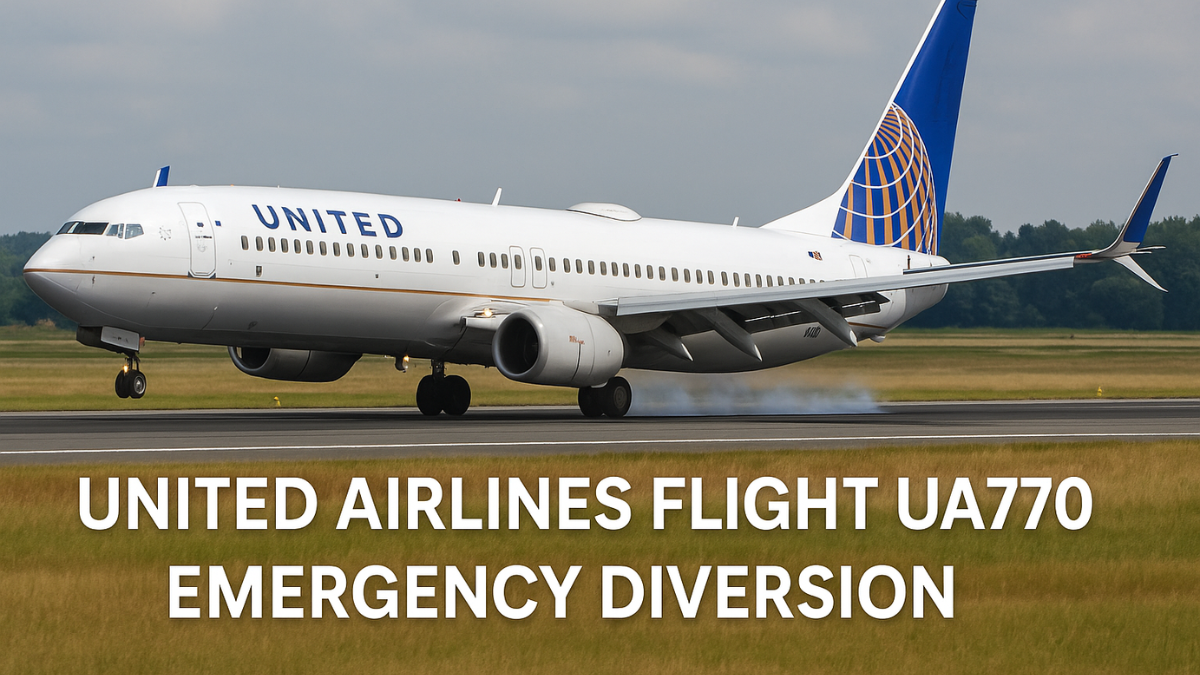The recent United Airlines Flight UA770 emergency diversion has become a topic of discussion among travelers, aviation professionals, and safety analysts alike. With increased public interest in aviation safety, any incident involving an emergency diversion naturally attracts attention. In this detailed article, we’ll explore everything that happened on UA770, the reasons behind the diversion, the airline’s response, and what passengers should know about such situations.
also read: https://usaenliinea.com/explore-famousparentingg-com-a-complete-guide-to-trusted-parenting-advice/
Understanding the Basics of Flight UA770
Flight Details:
United Airlines Flight UA770 was scheduled to travel from Los Angeles International Airport (LAX) to Washington Dulles International Airport (IAD). It’s a transcontinental flight, typically serviced by a Boeing 757 or 737, depending on the day and demand.

Flight Route & Purpose:
The route from LAX to IAD spans approximately 2,300 miles. It’s a commonly traveled path by both business professionals and leisure travelers. Flight UA770 caters to a significant volume of passengers due to its ideal timing and direct service.
What Caused the Emergency Diversion?
In-Flight Emergency Scenario
During the flight, somewhere over the central part of the United States—reportedly near Kansas—pilots encountered an in-flight issue that required immediate attention. Initial reports from passengers and flight tracking data indicated a rapid descent and sudden course deviation from the expected path.
According to United Airlines and air traffic control communication, the emergency diversion was due to a mechanical fault in the aircraft’s cabin pressurization system. Such systems are crucial for maintaining safe oxygen levels inside the plane while flying at high altitudes.
Why This System is Critical
The cabin pressurization system ensures that passengers and crew can breathe comfortably at cruising altitudes above 30,000 feet. If this system fails, it can lead to symptoms like headaches, dizziness, and even unconsciousness if oxygen levels drop significantly.
Due to this potential risk, federal aviation regulations require that the aircraft descend quickly to a lower altitude (usually around 10,000 feet or lower) and divert to the nearest suitable airport.
The Pilot’s Response and Decision-Making
The captain and first officer followed standard emergency procedures immediately. They declared an emergency with Air Traffic Control (ATC) and began a rapid descent to a safer altitude.
Chosen Diversion Airport
The flight ultimately diverted to Denver International Airport (DEN). This airport is well-equipped with long runways and advanced emergency support facilities, making it ideal for such landings.
Upon landing, the aircraft was met by emergency responders as a precaution. Fortunately, there were no reported injuries among the passengers or crew.
Passenger Experience and Airline Response
Inside the Cabin During the Diversion
Passengers reported hearing a loud noise followed by an announcement from the flight deck regarding an emergency landing. Oxygen masks did not deploy, suggesting the pressure loss was not sudden or complete. Cabin crew remained calm and provided necessary information and assistance.
Most passengers praised the airline’s crew for their calm demeanor and clear communication, which helped prevent panic.
Post-Landing Protocols
Once on the ground at Denver International Airport, passengers were deboarded and provided refreshments. United Airlines arranged alternative flights and hotel accommodations for affected passengers.
A statement from United Airlines later confirmed the incident and emphasized that safety is their top priority. The airline also initiated a full technical inspection of the aircraft.
Technical Analysis of the Incident
To understand the United Airlines Flight UA770 emergency diversion from a technical standpoint, we must look at common causes of pressurization issues:
| Possible Cause | Explanation |
|---|---|
| Malfunctioning outflow valve | Controls air pressure inside the cabin |
| Faulty cabin pressure controller | Regulates altitude pressure settings |
| Leak in fuselage or door seals | Causes slow loss of cabin pressure |
| Electrical system failure | Can disrupt automated pressure monitoring |
According to aviation maintenance experts, all these systems undergo rigorous checks before takeoff. However, failures can still occur due to wear and tear or undetectable issues during ground inspections.
Flight Diversions: How Common Are They?
Emergency diversions like that of UA770 are not extremely rare, but they are also not everyday occurrences. The Federal Aviation Administration (FAA) allows for diversions whenever the safety of the passengers or crew may be compromised.
The most common reasons for diversions include:
- Mechanical issues (like pressurization failure)
- Medical emergencies on board
- Severe weather along the planned route
- Security concerns or unruly passengers
Airlines are trained to handle these situations efficiently, and their crews undergo routine simulations to ensure readiness.
Implications for Airline Safety
The UA770 incident shows that emergency protocols work. While the idea of an emergency diversion may sound alarming, the aircraft’s systems and crew functioned exactly as intended.
United Airlines’ immediate actions post-landing and their transparency indicate a strong safety culture. Aviation experts agree that such events, while serious, should not deter travelers, especially when the response is swift and responsible.
How United Airlines Handled Public Relations
One of the major aspects of handling such an event is communication. United Airlines was quick to issue a public statement, explain the cause, and assure travelers of their safety commitments.
They also worked closely with media outlets to provide accurate updates and prevent misinformation. The airline’s social media teams also responded to passenger concerns, which helped rebuild confidence.
Lessons for Passengers and What to Expect
Passengers often wonder what they should do in such emergencies. Here’s a simplified breakdown:
| Action | Why It Matters |
|---|---|
| Follow crew instructions | Cabin crew are trained for such situations |
| Remain calm | Helps reduce panic and allows better coordination |
| Use oxygen masks if needed | Crucial in case of depressurization |
| Don’t speculate | Wait for official updates from the airline |
In the case of UA770, the crew’s preparedness made all the difference. Passengers were guided properly, no injuries occurred, and everyone reached safety.
FAQs About United Airlines Flight UA770 Emergency Diversion
1. Was Flight UA770 a Boeing 737 or 757?
While not officially confirmed, UA770 is often operated using a Boeing 757 due to the long-distance route.
2. Did any passengers require medical attention?
No medical emergencies were reported among the passengers or crew.
3. How long did it take to land after the issue was detected?
The plane began descent within minutes and landed safely at Denver within approximately 25–30 minutes.
4. Were oxygen masks deployed during the flight?
According to passenger reports, the oxygen masks did not deploy, indicating a controlled descent.
5. Was compensation offered to affected travelers?
United Airlines provided hotel accommodations, meal vouchers, and alternate travel arrangements.
6. Has the aircraft been returned to service?
As per standard practice, the aircraft will undergo a detailed inspection before re-entering service.
7. Did the FAA investigate the incident?
All such diversions are reported to the FAA, who may conduct follow-ups based on severity.
8. How do pilots decide which airport to divert to?
Pilots consult with air traffic control and company dispatch to find the safest, closest, and most equipped airport.
9. Can passengers file a complaint or request refunds?
Yes, passengers can contact United Airlines customer service for compensation or flight change inquiries.
10. Will this affect United Airlines’ safety rating?
Not necessarily. An emergency response handled correctly typically reflects positively on airline safety.
Conclusion: What the UA770 Emergency Diversion Teaches Us
The United Airlines Flight UA770 emergency diversion serves as a strong example of aviation safety systems working precisely as designed. Despite a mid-air mechanical issue, the experienced crew, supportive airline protocols, and responsive ground teams ensured every passenger’s safety.
This event reminds us that air travel remains one of the safest modes of transportation, thanks to well-established emergency procedures and ongoing safety enhancements. While diversions are disruptive, they are proof of an airline’s commitment to putting safety above all else.
Passengers can take comfort in knowing that, even at 35,000 feet, they are in the capable hands of professionals trained to handle any unexpected event.
also read: https://usaenliinea.com/vidmattapp-the-ultimate-guide-to-downloading-and-enjoying-videos-offline/
also read:https://usaenliinea.com/nhentai-het/
also read: https://usaenliinea.com/en-in-obnews-co/
also read: https://usaenliinea.com/gomyfinance-com-credit-score/
also read:https://usaenliinea.com/doujindesu/
also read: https://usaenliinea.com/the-techno-tricks/
also read: https://usaenliinea.com/sodiceram/







